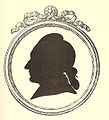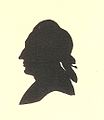Georg Friedrich Schmoll
Georg Friedrich Schmoll (* in Ludwigsburg ; † 1785 in Urdorf ) was a German draftsman and engraver .
Life
Schmoll initially came to Zurich for a limited period as a draftsman and engraver of portraits for Johann Caspar Lavater's Physiognomic Fragments . In 1774 he accompanied Lavater as a portraitist on a trip to Bad Ems . On this trip on the Rhine, Schmoll made numerous portraits (including of Pfeffel , Lenz and Merck ) as well as art sheets using various techniques, some of which he engraved in copper after his return. His main work is a series of portraits by Johann Wolfgang von Goethe , some of which were published in the large and small editions of Physiognomische Fragmente in 1775 and 1786, respectively. The 3/4 portrait of Goethe, created on the Rhine journey, played an important role in Lavater's teaching as a "prototype". Schmoll was unable to maintain the friendship he had with Goethe during the trip by publishing the portraits through which Goethe saw himself exposed to the public. After marrying Anna Lavater, nee Schinz, Lavater's sister, he moved to Urdorf, where he died early in 1785. Schmoll's register of the journey through the Rhine has been preserved with significant entries by Goethe such as “Künstler Erdewallen”. The Lavater biographer Georg Geßner calls him "a certain, fairly finished, quick and happy portrait artist".
Works
In the physiognomy of Schmoll's etchings, the outline drawings based on Hogarth, The Unbeliever Thomas based on Raphael and an Ecce Homo based on Rembrandt are named. Johann Heinrich Lips , Daniel Berger and Johann Rudolf Schellenberg engraved his drawings .
Five portraits by Johann Wolfgang Goethe from 1774 on his trip to the Rhine have come down to us as drawings, engravings or silhouettes. The drawings and the copper engravings made by Michael Wachsmuth from Goethe's parents have survived. Schmoll's version of the copperplate engravings by Goethe's parents has been lost. They formed the family plate with the 3/4 portrait of the Lahn trip . This is received in a modified arrangement in the version by Wachsmuth. Despite a few shortcomings, the family portraits of the Goethe family can be described as Schmoll's most important work because of their importance:
Johann Wolfgang Goethe in the red jacket with a hairnet to the left
- 1) The half-portrait in the oval to the left: Goethe with a hairnet and a large hair bow in a red jacket, from June 25, 1774
- 2) The colored half-portrait in the rectangle to the left: Goethe with hairband and red jacket, June 1774
- 3) The 3/4 portrait in the oval to the left: Goethe with a hairband in a gray hooded collar, of unknown date on the Rhine journey
- 4) The outline drawing in a circle to the right: Goethe with a large hair bow and in a gray hooded collar, July 1774 in Bad Ems
- 5) The copper vignette to the right: Goethe with a large hairband and in a gray hooded collar, July 1774
Web links
| personal data | |
|---|---|
| SURNAME | Schmoll, Georg Friedrich |
| BRIEF DESCRIPTION | German draftsman and engraver |
| DATE OF BIRTH | 18th century |
| PLACE OF BIRTH | Ludwigsburg |
| DATE OF DEATH | 1785 |
| Place of death | Urdorf |










